

A sinkhole, also known as a cenote, sink, sink-hole, shakehole, swallet, swallow hole, or doline (the different terms for sinkholes are often used interchangeably), is a depression or hole in the ground caused by some form of collapse of the surface layer. Some are caused by karst processes - for example, the chemical dissolution of carbonate rocks or suffosion processes.
Sinkholes may vary in size from 1 to 600 m (3.3 to 2,000 ft) both in diameter and depth, and vary in form from soil-lined bowls to bedrock-edged chasms. Sinkholes may be formed gradually or suddenly, and are found worldwide. These terms are often used interchangeably, though many distinguish between features a surface stream flows into and features with no such input. Only the former are described as sinks, swallow holes or swallets. A sinkhole on a glacier is called a moulin or a glacier mill.
The mechanisms of formation involves natural process of erosion or gradual removal of slightly soluble bedrock (such as limestone) by percolating water, the collapse of a cave roof, or a lowering of the water table. Occasionally a sinkhole may exhibit a visible opening into a cave below. In the case of exceptionally large sinkholes, such as Cedar Sink at Mammoth Cave National Park, USA, a stream or river may be visible across its bottom flowing from one side to the other.
Sinkholes can also form when natural water-drainage patterns are changed and new water-diversion systems are developed. Some sinkholes form when the land surface is changed, such as when industrial and runoff-storage ponds are created; the substantial weight of the new material can trigger an underground collapse of supporting material, thus, causing a sinkhole. Read more
Massive sinkholes in China hold 'heavenly' forests with plants adapted for harsh life underground Live Science - July 30, 2024
Plants growing at the bottom of sinkholes in China's Dashiwei Tiankeng Group don't take up as much carbon as surface plants do, but they have much higher levels of nutrients in their tissues.
A Drone Flew Into Siberia's 'Doorway to The Underworld' And The Footage Is Epic Science Alert - July 26, 2023
Watch drone delve into Siberia's growing 'gateway to the underworld,' the largest permafrost depression in the world Live Science - July 26, 2023
How To Detect A Sinkhole - Before It Swallows You Up IFL Science - July 22, 2023
The geology of the rocks beneath you is a clue to the possibility of sinkholes. Limestone is prone to dissolution by groundwater which can, over time, create enormous networks of underground caves known as karst. These can collapse downwards due to gravity, leading to great surface depressions and subsidence damage and even the complete loss of houses.
World's Second-Deepest Blue Hole Discovered Off Mexico's Coast IFL Science - April 23, 2023
The second-deepest blue hole in the world has been discovered in the bay of Chetumal in Mexico. With a depth of 274 meters (899 feet), this massive marine cavern has been named Taam ja', which means 'deep water' in the Mayan language.
A Giant Sinkhole Has Been Discovered in China With Its Very Own Forest Science Alert - May 12, 2022
The sinkhole is 630 feet (192 meters) deep, according to the Xinhua news agency, deep enough to just swallow St. Louis' Gateway Arch. A team of speleologists and spelunkers rappelled into the sinkhole on Friday (May 6), discovering that there are three cave entrances in the chasm, as well as ancient trees 131 feet (40 meters) tall, stretching their branches toward the sunlight that filters through the sinkhole entrance.
Sinkholes as big as a skyscraper and as wide as a city street open up in the Arctic seafloor Science Alert - March 17, 2021

Giant "sinkholes" - one of which could devour an entire city block holding six-story buildings - are appearing along the Arctic seafloor, as submerged permafrost thaws and disturbs the area, scientists have discovered. But even though human-caused climate change is increasing the average temperatures in the Arctic, the thawing permafrost that's creating these sinkholes seems to have a different culprit - heated, slowly moving groundwater systems.
The Arctic permafrost at the bottom of the Canadian Beaufort Sea has been submerged for about 12,000 years, since the end of the last ice age, when meltwater from glaciers blanketed the region. Until now, the frozen seafloor had been hidden from scientists' peering eyes. This remote part of the Arctic has only recently become accessible to researchers on ships as climate change causes the sea ice to retreat, the researchers said.
As of May 2018, sinkholes are increasing in number around the world due to rapidly increasing Earth Changes. This week a sinkhole was discovered on the White House lawn creating humor and symbolism.
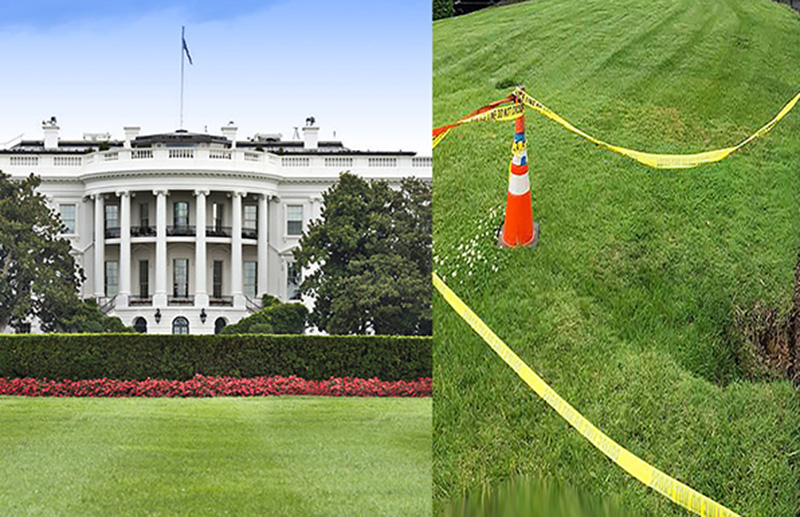

'Sacred sinkhole' discovered under 1,000-year-old Mayan temple... and it may eventually destroy the pyramid Daily Mail - August 17, 2015
It is a towering testament to a long dead civilization and has fascinated archaeologists for more than 150 years, but one of the most famous Mayan pyramids has been hiding a secret beneath its mighty steps. Researchers have discovered an enormous sinkhole beneath the 1,000-year-old Temple of Kukulkan, also known as El Castillo, which dominates the Mayan city of Chichen Itza in the northern Yucatan Peninusula of Mexico. And they fear the underground cavern, or cenote, which has a river running through it, may eventually cause the entire pyramid to collapse if its roof gives way.
Massive sinkhole opens in Brooklyn NY Post - August 6, 2015
The last major sinkhole in my area was on 3rd Avenue and 92nd Street in Bay Ridge.
This sinkhole is on 5th Avenue and 64th Street just down the street from the Lexus dealership where I bought my car.

Walking under the BQE (Brooklyn Queens Expressway) which is under construction and may have contributed to the problem.
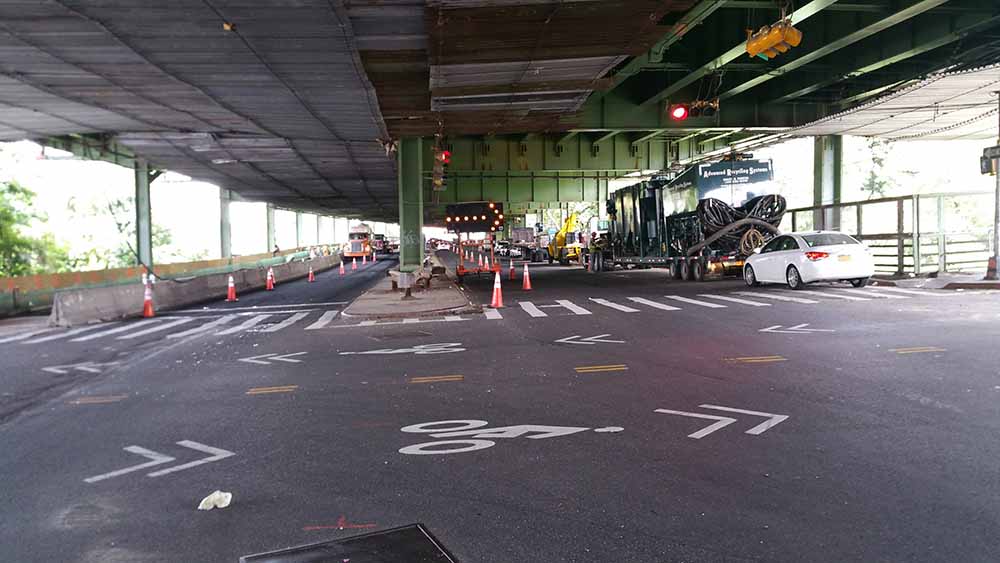
It will take months to repair.


I turned to take a pic looking down at the train tracks below.
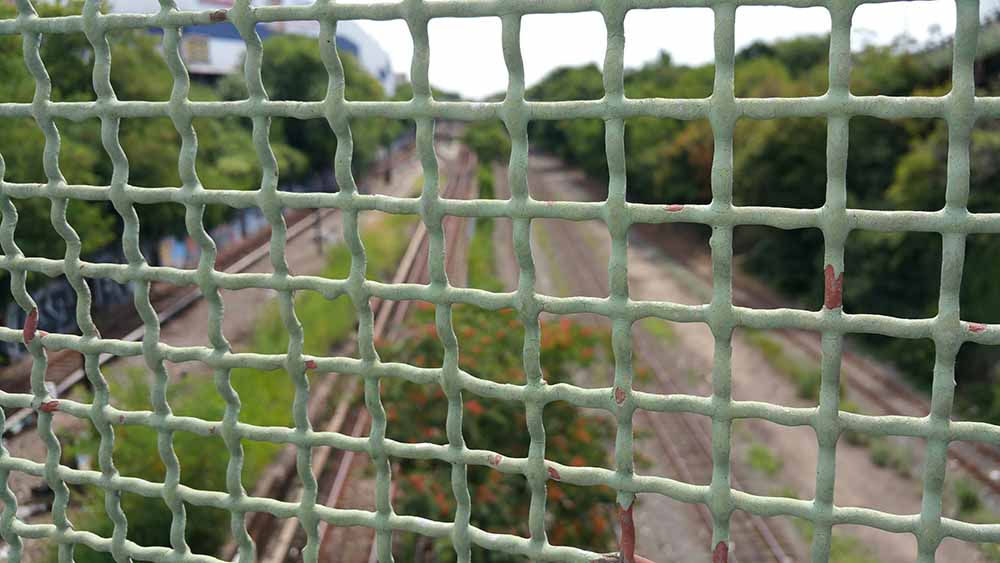

Quite a Jolt: Earthquakes Heralded Opening of Sinkhole Live Science - April 18, 2013
Earthquakes signaled the opening of a giant toxic sinkhole in southeastern Louisiana last year, researchers reported here today (April 17) at the Seismological Society of America's annual meeting. Strong shaking first rattled residents of Bayou Corne on June 8 and July 3 in 2012, prompting officials to install earthquake monitors near the small town. After July 14, seismometers detected 10 to 12 sharp tremors of about magnitude 2.5 jolting the region daily, said Steve Horton, a seismologist at the University of Memphis and lead study author.
A sinkhole was formed suddenly in Guatemala in May 2010, where torrential rains from Tropical Storm Agatha and a bad drainage system were blamed for creating a sinkhole that swallowed a three story building and a house. This sinkhole measured approximately 66 feet (20 m) wide and 100 feet (30 m) deep. A similar hole had formed nearby in February 2007.
However, geologist Sam Bonis says that actually it is not a sinkhole but a "piping feature". Guatemala City is built mainly on pumice fill and, according to Bonis, "When you have water flowing from storm water runoff, a sewage pipe, or any kind of strong flow, it eats away at the loose material. We don't know how long it has to go on before it collapses. But once it starts collapsing, God help us."
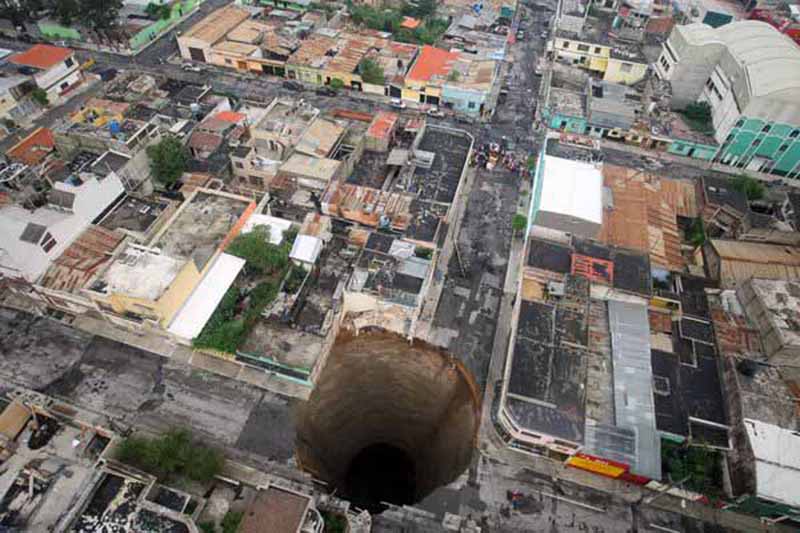
 Guatemala Sinkhole 2010
Guatemala Sinkhole 2010
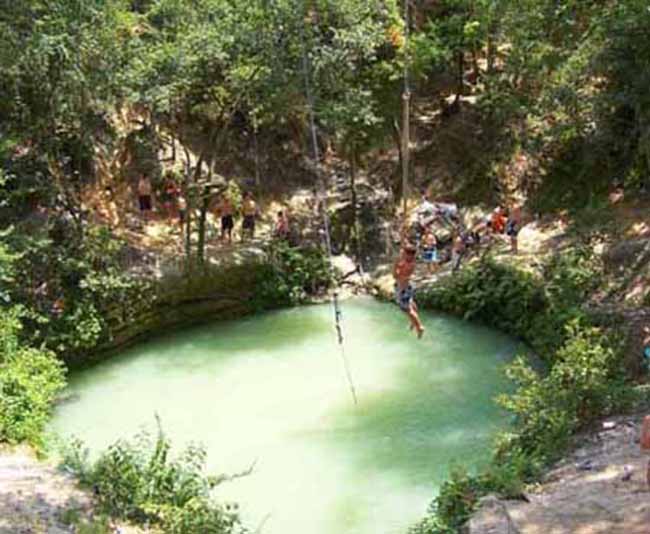
Devil's Millhopper near Hawthorne, Florida, USA.
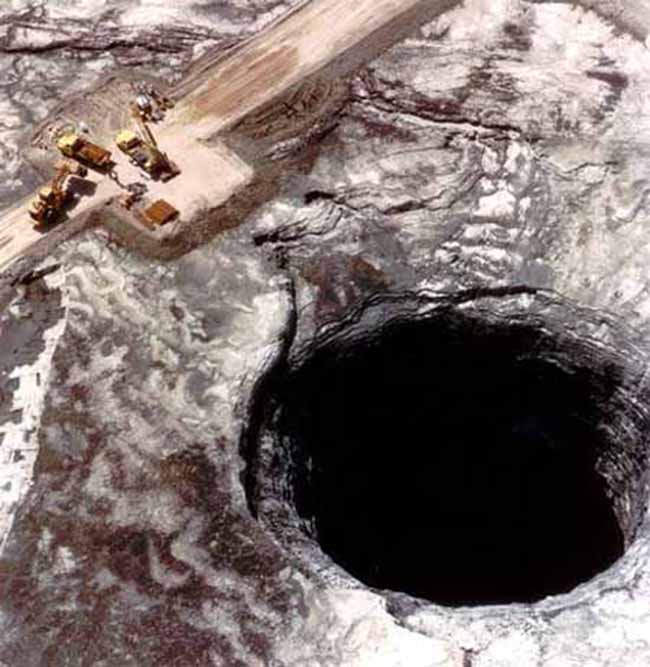
Mulberry, Florida, Sinkhole
A blue hole is a submarine cave or sinkhole. They are also called vertical caves. There are many different Blue Holes located around the world, such as in the Bahamas and in Belize.
Blue holes are roughly circular, steep-walled depressions, and so named for the dramatic contrast between the dark blue, deep waters of their depths and the lighter blue of the shallows around them. Their water circulation is poor, and they are commonly anoxic below a certain depth; this environment is unfavorable for most sea life, but nonetheless can support large numbers of bacteria.
The deepest blue hole in the world - at 335 metres (1,100 ft) - is Tamaulipas, Mexico's Zacaton. The next deepest blue hole is Dean's Blue Hole at 202 metres (663 ft), located in a bay west of Clarence Town on Long Island, Bahamas. Other blue holes are about half that deep at around 100–120 metres (330–390 ft).
Blue holes formed during past ice ages, when sea level was as much as 100–120 metres (330-390 ft) lower than at present. At those times, these formations were subjected to the same chemical weathering common in all limestone-rich terrains; this ended once they were submerged at the end of the ice age.
Blue holes are typically found on shallow carbonate platforms, exemplified by the Bahama Banks, as well as on and around the Yucatán Peninsula, such as at the Great Blue Hole at Lighthouse Reef Atoll, Belize

Blue Hole in Belize
First discovered by Jacques Cousteau, one of the world’s most famous divers and marine conservationists, the Great Blue Hole in Belize is the best of the bunch, and every diver's dream. Measuring 305m (1,000 ft) across and 123 m (400 ft) deep, the Blue Hole is almost perfectly circular and can be found in Lighthouse Reef Atoll, about 60 miles from Belize City.
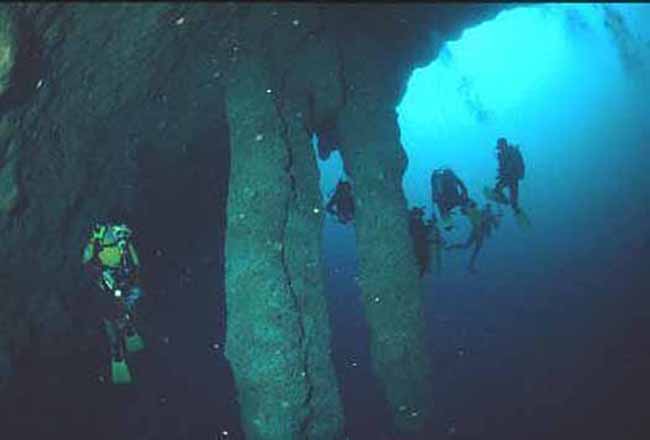
The Great Blue Hole in Belize is a Mecca for those wanting to dive among its giant stalactites and stalagmites that were formed during the last Ice Age. Starting at around 30-33 meters, the limestone formations become more intricate with depth, but few get to see what they look like as most divers are only qualified to go to a depth of around 30 meters, although, when it comes to diving in blue holes, many flout the rules.

Dean's Blue Hole
Dean's Blue Hole is the world's second deepest blue hole (underwater sinkhole), which plunges 202 metres (663 ft) to the ocean floor, in a bay west of Clarence Town on Long Island, Bahamas. The maximum depth of most other known blue holes and sinkholes is 110 metres (360 ft), which makes the 202 metres (663 ft) depth of Dean's Blue Hole quite exceptional, though Zacatón in Mexico is even deeper at 335 metres (1,099 ft).
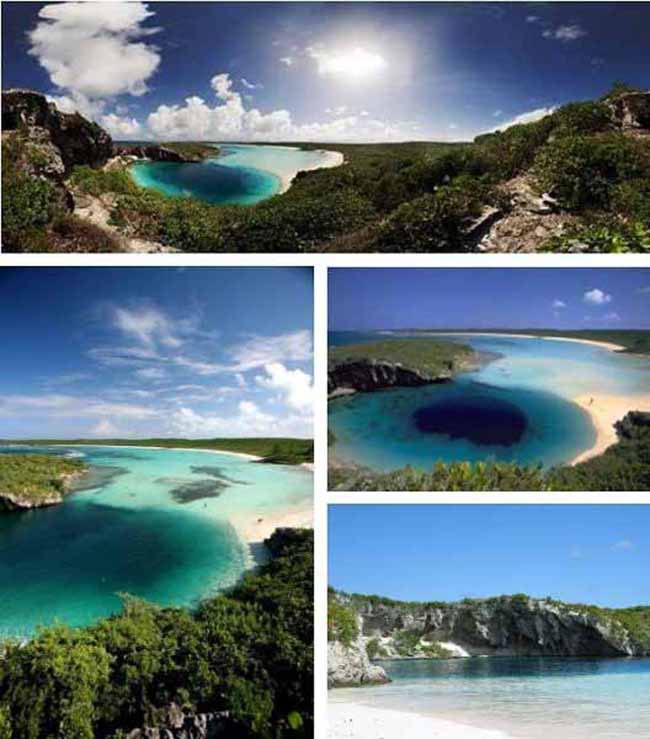
Dean's Blue Hole is roughly circular at the surface, with a diameter ranging from 25 to 35 metres (82–115 ft). After descending 20 metres (66 ft), the hole widens considerably into a cavern with a diameter of 100 metres (330 ft).
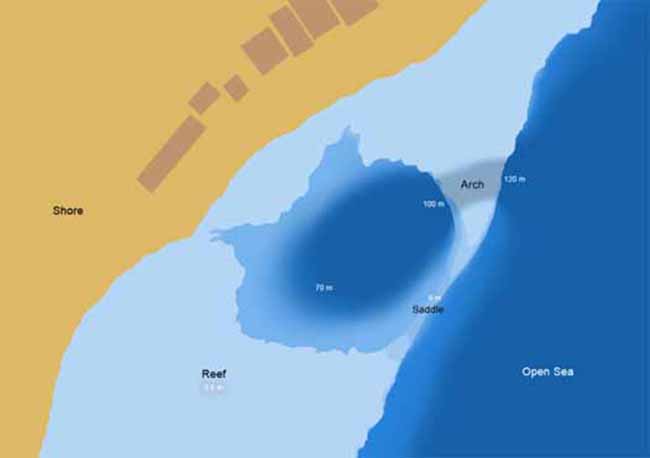
Blue Hole in the Red Sea
Blue Hole is a diving location on east Sinai, a few kilometres north of Dahab, Egypt on the coast of the Red Sea. It is a submarine pothole (a kind of cave), around 130 m deep. There is a shallow opening around 6 m deep, known as 'the saddle', opening out to the sea, and a 26 m long tunnel, known as the arch, the top of which lies at a depth of 52 m. The hole itself and the surrounding area has an abundance of coral and reef fish.

Dahab was a tiny Bedouin fishing village on the Sinai coast, about 50 miles from Sharm el-Sheikh to the south. Over the past 25 years it has become known worldwide for having great windsurfing conditions and some of the best shore diving anywhere.
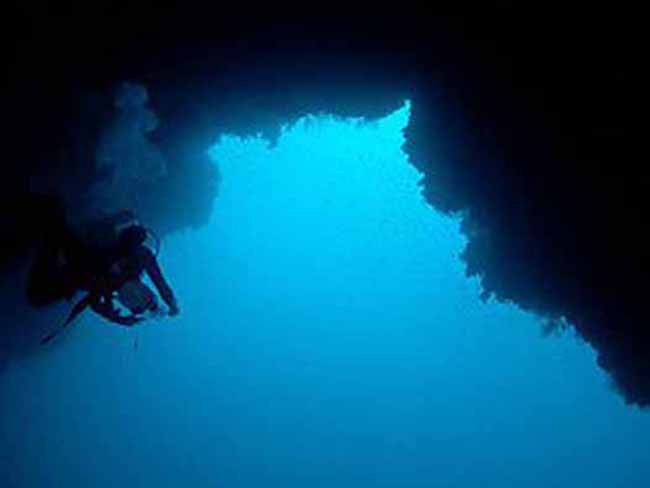
Technical diver passing under the Arch.
The Blue Hole, a short drive north of the main centre of Dahab, is notorious for the number of diving fatalities which have occurred there earning it the sobriquet, "World's Most Dangerous Dive Site" and the nickname "Diver's Cemetery". The site is signposted by a sign that says "Blue hole: Easy entry". Accidents are frequently caused when divers attempt to find the tunnel through the reef (known as "The Arch") connecting the Blue Hole and open water at about 52 m depth. This is beyond the PADI recreational diving limit (40 m), and the effect of nitrogen narcosis will be significant at this depth. Divers who miss the tunnel sometimes continue descending hoping to find the tunnel farther down and become increasingly narced.
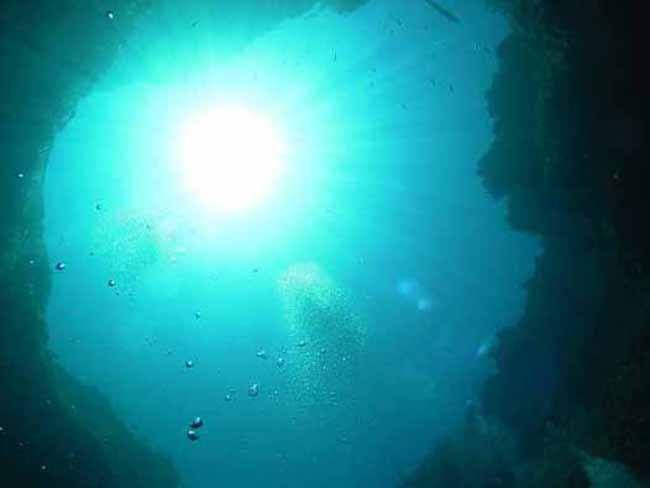
Gozo is a small island of the Maltese archipelago in the Mediterranean Sea. The island is part of the Southern European country of Malta; after the island of Malta itself, it is the second-largest island in the archipelago.
The Blue Hole of Gozo is not clearly as visible from the surface, the mouth to Malta’s Blue Hole starts at 7 m deep, and is the most popular dive site on the islands.
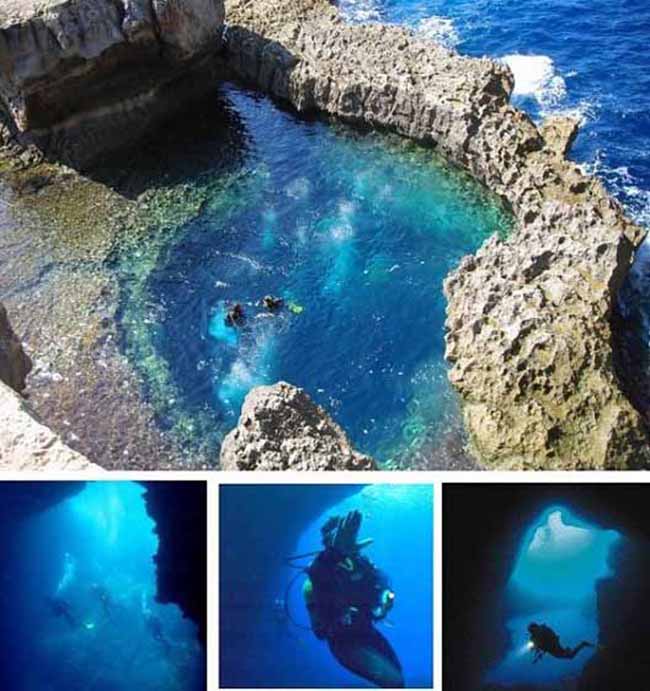
Located within the blue hole is a cave at 15 m below where shoals of tuna, groupers and barracuda are often found hovering by the large boulders and rocks. Divers can swim through a short tunnel, or chimney, to get to a different area within the hole which has great coral gardens and reefs teeming with marine life, which is quite amazing considering how fished out many parts of the Mediterranean are.
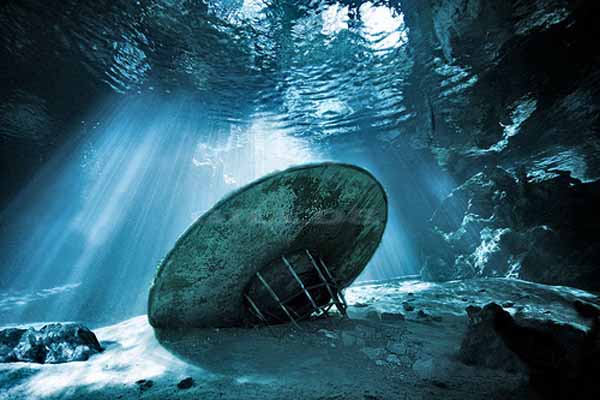
Extraterrestrial and UFO Files